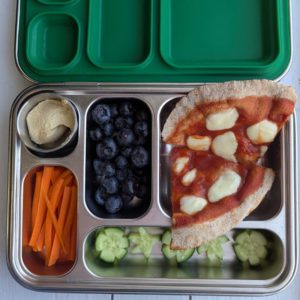
Having trouble keeping your 16-year-old from eating everything in the house? The amount of food a teenage boy can put away is legendary!
Besides sports, work, and other after-school activities and it’s a wonder they get anything else done but eat. Depending on activity level, boys between 14 and 18 can require 2200-3200 calories daily (1), and will often indiscriminately hoover-up whatever is put in front of them. This voracious eating makes for a great opportunity to help your child develop good habits that will prepare him for a lifetime of healthy eating.
Remember, not all calories are equal!
This is an important thing to remember! Just because your teen is engulfing everything in sight, if those are not healthy foods, he may not be adequately nourished. Calories from whole grains, lean protein, and dairy, fresh fruits, and vegetables, nuts, seeds and herbs, will contribute the nutrients he needs to support what can sometimes be astounding growth spurts. A 14-year-old freshman can start high school at 5’2” and finish his senior year a full foot taller! Since teens are adding muscle mass, bone structure, and blood volume during this time, what they eat directly impacts the quality of these body components. Iron and calcium are particularly important during growth, and these minerals are not readily available in processed junk food. So how are we to get nutritious food into adolescents who are also exerting their own will and are often not so receptive to parents’ good advice? See our pointers below:
Provide Healthy Snacks.
Given that boys at this stage of development are usually ravenously hungry, make sure options are available for meals and snacks that support good health. Get rid of sugary cereals, cookies, donuts, toaster tarts, salty chips and other processed foods that might be quick go-to snacks in your pantry. Instead, provide fruit and vegetables, already washed and cut up, front and center in the fridge for when he’s looking for something to eat. If he’s hungry, he will eat them!
- Have dips available for the cut-up veggies right alongside, like hummus or guacamole.
- Purchase sliced cheese that he can eat with fruit – always an amazing combination!
- Have yogurts that are low in sugar available to eat with sliced fruit.
- Keep bananas on hand. When they get home from school, they can quickly assemble cereal with banana and low-fat milk. Check the package label: only buy cereal that lists whole grains first in the ingredient list and contains less than 6 grams of sugar per serving.
- Have peanut or other nut butters in the pantry alongside whole grain bread or crackers. Sesame seed butter is a great alternative if there are nut allergies in the house.
Don’t Skip Breakfast.
Encourage breakfast that includes protein. It will help to keep your teen full until lunchtime and allow them to better focus during school. Some of our favorites:
- Oatmeal with 2 tbsp almond or peanut butter and sliced bananas, one hard-boiled egg on whole grain toast, and juice. The oatmeal and eggs can be made the night before to ease morning frenzy. The oatmeal can be rewarmed in the microwave for 1 minute, adding more liquid if needed (or try instant oats, prepared easily and quickly in the microwave). The egg can be placed into a warm bowl of water as you’re waiting for toast. Try over-night oats for those mornings you know you’ll be rushing out the door.
- On a whole grain wrap, add two, quickly pan-scrambled eggs. Quickly warm pre-sliced mushrooms and peppers, in the same pan, add to wrap, and top with two tbsp of shredded cheese. Roll up. Provide sliced pears or apples on the side.
- Look for high-quality, whole grain, low-sugar, boxed cereals. Have your child top it with milk and banana slices. Save a few slices, smear with peanut or other nut butters, for added protein.
Give a Gentle Lunch Reminder.
During the week, your teenager likely eats at the school cafeteria or goes out to neighboring fast food restaurants. Remind him that salads are usually available. Adding a tomato and greens on a burger makes a good food better. Occasionally switching it up to a turkey or chicken burger could also be encouraged. Does he love pasta? Encourage him to add some veggies and grilled chicken to the penne. And pizza can be made more nutritious with spinach, peppers and other veggies. On weekends, lunch can be dinner leftovers (if you actually have some!) or a salad and sandwich.
- Dinner is your time to provide him with a bounty of nourishing food. After sports and other activities, his body needs a nutritious meal to replenish his energy stores. After activity, it’s important to eat a balanced meal that includes protein for muscle repair along with whole grains, fresh vegetables, fruit and dairy for his other nutrient needs. For fun and delicious dinner suggestions, check out our meal tip section. These recipes have busy families and their wallets in mind. Some of our favorites:
- Lasagna Stuffed Peppers Everyone loves the flavors of lasagna but this recipe does it one better. It’s chock full of delicious and nutritious vegetables. Your child will eat it up!
- Sauteed Vegetables Over Brown Rice This easy and inexpensive meal can be made in a hurry and in mass quantities. Keep leftovers handy in the fridge for when he needs another helping, which might just be in a few short hours!
- No Mess Salmon & Broccoli Foil Packs with Marinated Cucumber & Chickpea Salad Ready in under 30 minutes, this recipe couldn’t be easier! It’s nutritious and delicious and won’t break the bank.
Since it is often challenging to keep an eye on foods teens consume outside the home, it is important to make sure that in the house, delicious and nutritious options are what’s readily available. Keeping it cool and not overly “sermonizing” about junk food he may be having while out of the home is wise – this is a teenager after all! Modeling healthy eating behaviors helps too, more than you might expect. Your child naturally internalizes the habits you display, and this information can wire him to make good choices when he grows up and is on his own. By creating a positive food environment at home, guiding him towards nutritious choices, and modeling good eating yourself, your teenager will grow into a healthy eater for life.












